- Bernard Preston homepage
- Bread
- Sourdough Bread Recipe
Sourdough bread recipe
Sourdough bread recipe is how the ancients made the daily loaf before the advent of commercial raising-agents; this page is about making your own starter.
There are at least four kinds of sourdough starters, often called pre-ferments.
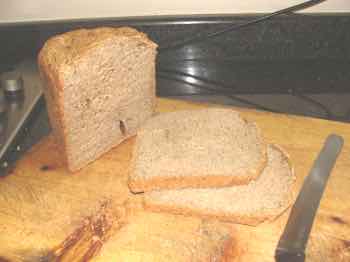 Soft, light sourdough bread
Soft, light sourdough bread- Sponge starter. This is the type described below; it is a liquid pre-ferment often used for enriched loaves such as our artisan bread with added hummus.
- Poolish starter. This is rather thicker with a very little added yeast; or it will over-ferment.
- Biga-starter. This is stiffer yet with a 2:1 flour to water ratio; and again a little added yeast.
- Pate fermentee. Keep back a bit of the dough each day; and use it to start the new-recipe tomorrow.
Ingredients
- 30g unbleached-flour (1/4 cup)
- 30g warm unchlorinated water (2 Tbsp)
Go for it
- 5 days: Feed morning and evening, water and flour.
- Fork vigorously and scrape the sides of the container.
- Discard half each day.
- Fork several extra times each day.
- Days 6 - 28: It should rise and fall. Keep it thick.
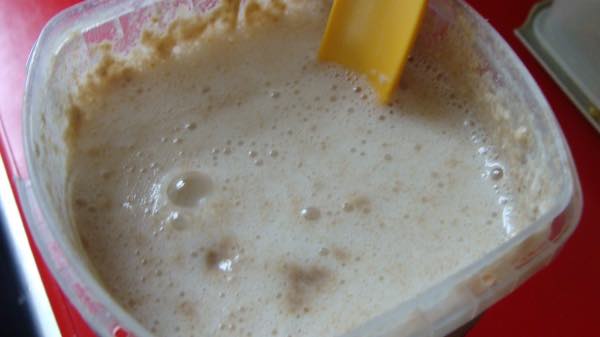
During the first 48 hours if there is sufficient oxygen, the yeast cells will divide rapidly providing plenty of oomph for your dough; so fork it vigorously to incorporate as much air as possible. Thereafter it switches to anaerobic respiration and the production of the acids that give your loaves their delicious sour flavours.
"For so basic a commodity, bread has a symbolic and metaphorical-richness that few other foodstuffs can match."
- Darryl Accone
This page was last updated by Bernard Preston on 9th March, 2023.
Both whole rye and wheat flour contain yeasts and bacteria which ferment
the sugars in the carbohydrate, producing gas to make the dough rise.
Remember that a starch is simply a very long chain of glucose-molecules
joined together in different ways; some are branched making it easier for the enzymes to digest them.
Whole dark rye flour is the best but it is difficult to get; so we just use 100% wheat meal instead. Lactobacillus and various natural
yeasts in the bran get on with what they do best once you add water and put your
starter in a warm place.
Chlorine will kill the bugs, so use spring or rainwater; it should be warm, at around blood temperature. Bleaching of flour too kills the natural friendly-bacteria and yeasts found in the hull of the grain; avoid it.
Keep your starter whilst you are preparing it as close to 30 degrees Celsius as possible; that is about 86oF. Thereafter it may live in the refrigerator unless you want a strong and more sour loaf, which is what I recommend; a better pre-fermentation will be achieved.
That will mean less of the symptoms of gluten intolerance that you may be experiencing. The phytase enzyme also reduces the so-called antinutrients that unnecessarily confuse many people. Fully fermented sourdough bread need not concern you in this regard; it will not inhibit the absorption of minerals as the industrial loaf may.
Put your growing starter in a warm, darkish place; top of the fridge or in the battery room if you have a solar generator which both produce a steady heat. If it's too cool the fermentation-process will slow down.
Look upon baking this sourdough bread recipe as an adventure; there will be disappointments and wonderful successes. The satiety alone that it provides is a good reason to get baking; one slice is enough.
A teaspoon of raw-honey may help the process along by providing more yeast cells and readily available sugars; the pasteurised stuff from the supermarket is probably quite useless. Try though if you have no other option.
However raw honey also has antiseptic properties so I use it no longer; no sugars are necessary for making the starter.
The fermentation by the lactobacillus also reduces
the effect of the phytates in the bran mentioned above; that may bind minerals like calcium
that our bodies need. It is significantly more effective at deactivating the anti-nutrients than conventional commercial yeast.
Talking of calcium, 100 percent wholemeal flour that has been fully-fermented is a good natural source of the mineral; taking it in supplemental form incidentally gets deposited in the intima of the coronary arteries which research shows increases the spectre of heart disease. As Hippocrates said, let your food be your medicine.
Later we will consider kefir sourdough-bread; that is even richer in calcium.
Sponge Starter
For your starter you can either get it from a friend, or make your own. This is a very simple seven-day process.
On the first day mix about three tablespoons of the best wholemeal flour you can acquire and a quarter of a cup of warm spring water in a glass or plastic container with a loose-fitting lid.
Keep it in a warm place. Initially it has to be fed and stirred twice daily.
A clear liquid may form at the top; it's called hooch and means your mother wants to be fed.
- More sour: Feed once a day and keep it cooler.
- Sweeter: Feed twice a day at a warmer temperature.
It becomes a bubbling, living creature; look upon it as a pet but once mature after 6-weeks you only
have to feed it now and then, depending on how often you bake your
sourdough bread recipe.
On day two discard half the mixture, add a further three tablespoons of flour and another quarter cup of warm spring water to your concoction; again stir it into a sloppy paste. Keep fruit flies out; it gives off carbon-dioxide so the lid may burst off.
Just toss that discard into anything you are baking; there's a build up of waste products from yeast and bacterial metabolism that will slow the growth of your pet.
It's not really strong
enough yet for proper sourdough bread but will work fine in a recipe
using some dried yeast; or biscuits and pancakes.
Over the next five days repeat what you have been doing. It will start to froth and bubble; luckily there should be no trouble.
On the seventh day your starter will be ready for early trials but it's not fully fermented for 6-weeks.
Maintaining your starter is very simple; every time you use a couple
tablespoons of the paste, add more flour and unchlorinated water. The quantities are not really important; it is very tolerant. Place it in the fridge if you are not baking regularly; it will just go to sleep.
Do try to be as sterile as possible though; I keep my fingers out, for example and use only clean cutlery. Nevertheless it will naturally acquire more bugs from your environment; it can't be helped.
For the average person, let us keep it simple; your sourdough bread starter is amazingly robust. You could not feed it for a month and it will survive.
If it rises too much, called over-proofing and then collapses, try keeping it in a cooler place. That happens with many bread machines. It may affect the texture of your loaf but not the rich flavour and benefits of sourdough. If you add a little commercial yeast, use rather less.
Prep your starter before use
About two hours before mixing your dough, add some flour and unchlorinated water to your starter; fork vigorously.
Gluten intolerant
Having started this page with a quote about the symbolic and metaphorical richness of bread, this so-called basic foodstuff is quite seriously under threat in our modern world. There are many reasons.
- New varieties of wheat are much higher in protein so that some folk become intolerant to higher levels of gluten.
- Most bread today is junk food; made from highly-refined and bleached flour.
- The chemicals added to commercial bread cause bloating and discomfort.
- Low carb diets in an obese world recommend avoiding bread altogether.
Sourdough bread, the way it was made until the last century or so, has become a rarity today.
So if you are gluten intolerant, or suffer from Crohn's disease then you want an active and strong starter.
- Keep the mixture as thick as possible with plenty of unbleached flour; you want it sour smelling and bubbling. Do not put it in the fridge.
- Feed it every day with more flour, perhaps even oftener. Use some of the ferment in your general baking.
- Leave the dough at least overnight with the preferment and even longer, before baking. This gives the bacteria plenty of time to break down those protein fragments; and for the phytase to deactivate the anti-nutrients. They do cause trouble to some apparently.
Gluten is the protein in flour that enables the dough to hold its shape, allowing the baker to stretch and knead it.
Remove this gluten and it will fall flat as a pancake.
Gluten is definitely not public enemy number one; using a pre-ferment will help to completely digesting the protein fragments so that they do not cause havoc in the intestine. This is a massive issue and behooves all who love a good loaf to learn about real and fake bread.
Phytates
There is still is a lot of controversy about so-called antinutrients like phytates in grains, legumes and nuts; and seeds too. A group of extremists recommend we avoid these foods completely.
However these are many of the most nutritious and beneficial foods.
The trick is not to avoid them at all but to learn how to eliminate these anti-nutrients by correct processing; as has been done traditionally for millennia[3].
Anti-nutrients do bind many minerals so that absorption is significantly reduced. This can cause real problems in regard to our teeth and bones, for example but only for those on a poor diet. Vegetarians do not suffer from osteoporosis; in fact they are often stronger.
The traditional methods to deactivate anti-nutrients are the use of soaking, rinsing and fermenting of these wonderful foods.
And the sourdough culture contains bacterial species that produce an enzyme called phytase that neutralises the anti-nutrient; the longer the grain is soaked in the medium the more effective it is. A minimum of four hours is recommended.
Easy sourdough bread recipe
Now you have the starter for your easy sourdough bread recipe. A purist would knead it with no added commercial yeast.
I used to do it that way but now, with time restricted, I use a bread machine and cheat with a little commercial yeast to make a lighter loaf. You do it according to your preferences; there are so many options.
One thing is sure; having made your own sourdough bread, you will never readily go back to eating the commercial loaf. They are like chalk and cheese.
Pretty please, do not spoil it with margarine.
An enormous research project conclusively proves there is absolutely no benefit changing to hydrogenated oils; in fact they are highly detrimental.
In short, butter is back.
It is the hydrogenated oils that have now been shown to be the villains of the piece, not the saturated fat in butter.
Avoiding those foods to which trans-fats have been added is important.
Enjoying at least half a dozen coloured salads and fruits every day is the solution to keeping your cholesterol down and enjoying a body without inflammation and pain; and the phytosterols in nuts and seeds.
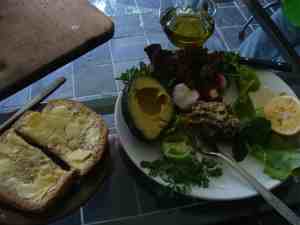
Low GI bread
To make low GI bread all you need is the above sourdough recipe to which you add extra fat and protein. I use a good scoop of our authentic hummus and another dab of butter.
Then you have a low GI sourdough bread recipe.
Actually that should read lower glycemic index. Real 100% wholemeal consists of 16pc resistant starch, compared to two percent in cake flour.
But it still has 84% carbohydrate that is digested in the small intestine forming glucose and possibly a spike in blood sugar; especially if you are insulin resistant. One slice is enough.
I am prediabetic and even our low GI bread produces an auspicious spike if enjoyed with a thick starchy soup. Glucometer testing has shown that taken with a large green salad, or being physically active after lunch prevents that unwelcome rise in blood sugar.
We should all consider using a continuous glucose monitor for a few weeks to determine which foods are undermining us.
Gluten intolerance
Celiac disease, a severe form of gluten intolerance in the gut, is not uncommon; roughly 1/200 people suffer from it, causing chronic diarrhoea. It is one of the autoimmune conditions that occur in certain genetically susceptible people. Total abstinence from wheat, rye and barley is generally recommended.
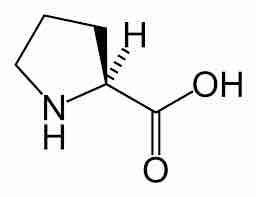 The amino-acid proline.
The amino-acid proline.Interesting research published in Applied and Environmental Microbiology reveals that 13 of 17 patients with Celiac disease in a double-blinded study did not react to sourdough bread[6].
Lactobacillus bugs in the sourdough starter were able to break down these gluten fragments which are high in proline. Note that the preferment time was 24 hours, much longer than our four.
On a personal note, I find ordinary supermarket bread often gives me severe indigestion, and it is tasteless; but I am far more tolerant of a sourdough loaf. I can even have half a slice at night, which I have not been able to enjoy for years.
Better still is since enjoying kefir every day, a probiotic, I am now able to eat this sourdough bread recipe freely at night.
We might be tempted to curse proline but, along with betaine and choline, it is one of those protector molecules in whole foods that keep our cells from damage by reactive oxygen species(4); meaning it lessens the risk of getting neoplastic diseases.
For the majority of us, proline is a friendly amino acid; but not for coeliacs in whom the gluten fragments are hugely problematic.
There are concerns however that gluten avoiders show an increased risk of heart disease, probably because of lower consumption of whole grains.
Researchers commenting in the British Medical Journal conclude that those not suffering from Coeliac disease, even if they are intolerant of supermarket bread should NOT be encouraged to go on a gluten-free diet[5]. This is a complex subject with many confusing opinions, even from the experts.
Update
Here is an update; I am now in the process of reducing the industrial yeast added to my sourdough bread recipe; so far I am down to 1/2 of what I use in my Panera bread recipe and it has had no obvious effect on the leavening process; the wild yeasts and lactobacillus in the sourdough starter are doing their trick.
If you have a serious gluten intolerance, remember you must use a much longer time, at least eight hours, before baking your dough.
Also, because of that very interesting research on how lactobacillus breaks down the proline rich fragments of gluten that make wheat indigestible and toxic for the bowel for many, I am extending the leavening time. Basically, I mix the dough, and then wait several hours before adding the yeast and switching the machine on to its bake cycle. In summer one would need perhaps to keep it in the fridge whilst it is curing; bread experiments continue. It is fun.
The aim of the exercise is to reduce the need for industrial dried yeast, quite a large part of the expense of your homemade bread, improve its digestibility whilst still keeping the process simple and hassle free. Slow food, made fast, remains our slogan.
In this instance, made simply might make more sense. We love the added dimension that pan-fried toast brings to our sourdough bread.
Sourdough
Sourdough is given its name with good reason; whilst proline has a sweet taste, its breakdown products may have a bitter, or acid flavour once acted upon by the bacilli in your starter. Much research has been done on this in the making of cheeses.
For the occasional baker, preserving sourdough starter will be useful.
Newsletter
Our newsletter is entitled "create a cyan zone" at your home, preserving both yourself and Mother Earth for future generations; and the family too, of course. We promise not to spam you with daily emails promoting various products. You may get an occasional nudge to buy one of my books.
Here are the back issues.
- Lifestyle and ideal body weight
- What are ultra-processed foods?
- Investing in long-term health
- Diseases from plastic exposure
- Intensive lifestyle management for obesity has limited value
- A world largely devoid of Parkinson's Disease
- The impact of friendly bacteria in the tum on the prevention of cancer
- There's a hole in the bucket
- Everyone is talking about weight loss drugs
- Pull the sweet tooth
- If you suffer from heartburn plant a susu
- Refined maize meal and stunting
- Should agriculture and industry get priority for water and electricity?
- Nature is calling
- Mill your own flour
- Bake your own sourdough bread
- Microplastics from our water
- Alternative types of water storage
- Wear your clothes out
- Comfort foods
- Create a bee-friendly environment
- Go to bed slightly hungry
- Keep bees
- Blue zone folk are religious
- Reduce plastic waste
- Family is important
- What can go in compost?
- Grow broad beans for longevity
- Harvest and store sunshine
- Blue zone exercise
- Harvest and store your rainwater
- Create a cyan zone at your home
These proline-rich fragments of gluten are the fly in the ointment, so breaking them down is what we are after; I recommend you gradually increase the time that your flour is exposed to the starter, getting used to the taste, until you find your happy medium.
And only leave it overnight and longer if you have a specific gluten-intolerance. I like the sour taste, but the good wife does not enjoy the bread when it gets too strong.
There are some concerns about the absorption of minerals from bread, particularly if there is added bran. Phytic acid binds to iron and calcium for example, reducing their absorption in the gut.
Exposing the dough to the affect of the bacteria in the starter greatly reduces this effect; it is not really a problem in whole foods, only when there is added smart-bran. Are phytates bad is the question occasionally heard; type it into the Site Search function in the main menu bar.
If you leave the dough plus starter for a longer period, for some reason the paddle in the bread machine doesn't always stir up the corners of the baking dish. Use a rubbermate to get into the nether parts before baking.
Make sure the paddle is free by twiddling it from underneath.
Have fun, this baking stuff is really interesting, and the subtle changes of flavour are truly remarkable, and more nutritious. Interestingly our hens go crazy over our stale sourdough bread, but often turn up their noses at the supermarket loaf; they are more discriminating than we humans are it would seem.
Pizza
For years I have been unable to enjoy pizza; a few hours later it feels like I have a lump of concrete in my stomach. The bloating and pain have completely put me off what was once a favourite food; and then the great discovery.
This sourdough pizza crust gives me no pain or discomfort at all, and it takes me less than half an hour of my time; it fits perfectly in with our philosophy of slow food, made fast.
Smart bran
Smart bran is to be found only by using 100% wheat flour, and frankly it is difficult to find. Do not be fooled by smoothing talking millers who describe their product as whole grain meal; they are allowed to do that, even though up to 40 percent of the goodies have been extracted. The bacteria in the sourdough bread recipe ameliorate the influence of any phytates.
If you want a nutritious sourdough bread recipe do not use added smart bran; but you may have to grind your own. The 100% wholemeal is from our twenty year old Hawo electric flour mill; expensive but still going strong. It has paid for itself many times over.
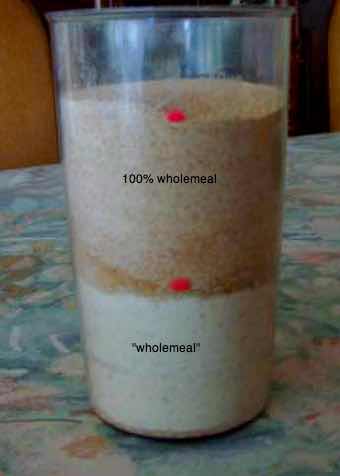
Research indicates that the bran in your 100% wholemeal is far more effective than that added to cereals and cookies. It is all about getting back to whole foods.
Industry loves to separate the bran, germ and endosperm into three separate streams and sell the parts back to you at a much higher price.
100% wholemeal means you will never need to buy bran, wheatgerm oil or vitamin E capsules; or bread flour, of course.
Nutritious flour
Does nutritious flour go bad, is a question often heard; it is certainly a concern if you are baking a sourdough bread recipe.
Wholewheat flour certainly does go bad if it still has the germ where the precious oils are located.
Store it in the deep freeze in an airtight container and, if you are serious about baking spend the money and buy a mill. They are expensive but they last for ever; ours in thirty years old and grinds away every day.
Storing wheat berries is for those who are serious about baking; the flour costs one quarter or less of the price of commercial flour.
Then you will have a ready source of freshly ground 100% wholewheat flour at about half the price of refined meal. In the short term your wellness will benefit within weeks; how much do you store do you place by that?
- Does flour go bad? Copy and paste it into the Site Search function in the main menu above.
Whole wheat vs full grain gives new insights into the deceit of the food manufacturing industry. There are a lot of hidden details when it comes to making your sourdough bread recipe.
Are you concerned about all the carbs in bread, and how fattening it is? If you are using refined flour, the way most commercial bakers do, with a few small specialist shops doing it the right way, then you need to be worried; it certainly does add on the pounds.
But if you use 100% wholemeal, the bran and essentially fatty acids in the wheat flour turn it into what is known as resistant starch; much passes through the small intestine largely undigested, producing no blood sugar rush, instead being fermented in the colon.
There is fascinating research being done on the connection between the friendly bugs in the colon, known as the microbiota, and prevention of the serious neurodegenerative diseases.
If you want to know more about the whys and wherefores then read about resistant starch.
Three types of sourdough
There are three types of sourdough bread recipes. Only the first uses no added yeast whatsoever, the way it has been made for thousands of years.
Types II and III use a leavening agent of sorts. Even some cakes are baked these days using sourdough.
Hunger
You may be concerned that our sourdough bread recipe will make you obese; relax, you need have no fears if you are using 100% wholemeal flour. It is the simple sugars and refined carbohydrates that get the hunger centre in the brain excited.
Just one slice of this nourishing loaf, with butter but no jams or jellies, will leave you satisfied, and with no hunger pangs a few hours later like the supermarket bread does.
Do some reading too on the subsequent meal effect of legumes.
Bread Matters by Andrew Whitley
Bread matters by Andrew Whitley is a must for serious home bakers; it is been a great help to me when wanting to understand the inner details for example of sourdough recipes.
Then perhaps you want to see how Jamie Oliver makes a sourdough bread recipe[2].
More sourdough starter recipes
There are 101 sourdough starter recipes. They all have one thing in common; a living culture of bacteria and fungi to make your bread rise.
Some like to use milk, others apples and grapes; I suspect they all work, though the living bugs in your starter will vary.
BBC's Paul Hollywood makes a starter from green grapes; perhaps you might like to try it. He is an engaging character, and his enthusiasm comes through for making sourdough bread.
Our recipe has a lower glycemic index, but that is not necessarily true of all sourdough bread. This is made from 100% wholewheat with added protein in the form of our homemade hummus. So you can without guilt enjoy a little butter and gooseberry jam recipe on it.
I am a great believer in probiotics. You can either make your own, like these kefir benefits, or you can pay quite a lot of money every month for them in capsules. It is basically a strong yoghurt with far more strains of friendly bacteria and yeasts. It has totally cured me of the heartburn and indigestion that I have suffered from for years when I had a carbohydrate-rich dinner.
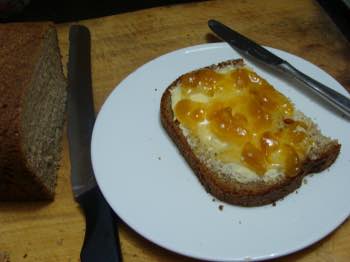
Bernard Preston
Bernard Preston is a lover of the mysteries and complexities of life; this sourdough bread recipe is just one of them. Plus he loves great food; the nutritious kind, and this tastes so good that he bakes it every single day.
Sometimes he bakes what he calls the best bread in South Africa twice a day; yesterday he gave a loaf to a friend who's son is severely asthmatic. Research shows that 100% whole wheat[1] and fish are greatly beneficial for those who wheeze.
Useful links
- Whole wheat
- Jamie Oliver makes Sourdough bread recipe.
- Living With Phytic Acid
- Proline, Betaine, and Choline Responses
- Long term gluten consumption in adults without celiac disease and risk of coronary heart disease
- Sourdough Bread Made from Wheat and Nontoxic Flours and Started with Selected Lactobacilli Is Tolerated in Celiac Sprue Patients
When browsing use right click and Open Link in New Tab, or you may get a bad gateway signal.
Did you find this page interesting? How about forwarding it to a friendly book or food junkie? Better still, a social media tick would help.
- Bernard Preston homepage
- Bread
- Sourdough Bread Recipe
Address:
56 Groenekloof Rd,
Hilton, KZN
South Africa
Website:
https://www.bernard-preston.com